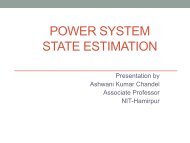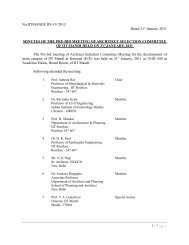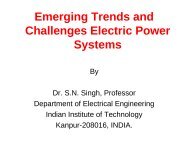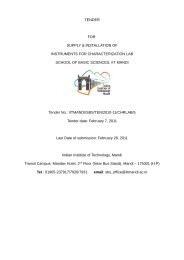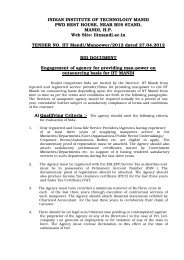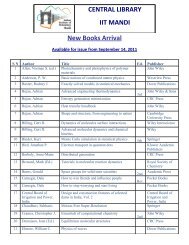Issue1. Vol.1 (April, 2013) - IIT Mandi
Issue1. Vol.1 (April, 2013) - IIT Mandi
Issue1. Vol.1 (April, 2013) - IIT Mandi
- No tags were found...
Create successful ePaper yourself
Turn your PDF publications into a flip-book with our unique Google optimized e-Paper software.
ESSENT Society for Collaborative Research and Innovation, <strong>IIT</strong> <strong>Mandi</strong>and k vary almost linearly and so g remainsalmost constant in this range.Piezoelectric Voltage Coefficientg (10 -3 VmN -1 )50403020100PZT - PVDFPZT - PMMA0 10 20 30 40 50Volume fraction of PZT in the Polymer ( % )Figure 3. Piezoelectric voltage coefficient (g) as afunction of volume fraction of PZT in the polymerThe microhardness values of the two types ofcomposites as a function of volume fraction isshown in Figure 4. The microhardness of thetwo composites are nearly equal up to 30%volume fraction of PZT. Beyond 30% themicrohardness of PZT–PMMA composites isabout 15% higher than that of PZT–PVDFcomposites. This is attributed to the bettercompaction of PZT–PMMA compositescompared to PZT–PVDF composites at highervolume fractions, which is evident from thedensity values .Figure 4. Microhardness as a function of volumefraction of PZT in the polymerConclusionThe results show that the piezoelectricparameters d and g are reasonably higher forPZT–PVDF composites than those for PZT–PMMA composites for volume fractions greaterthan 20%. These high values are mainlyattributed to the ferroelectric nature of thepolymer PVDF. The polymer PVDF is morecompliant than PMMA and hence PZT–PVDFcomposites have better mechanical stability thanPZT–PMMA composites. These results revealthat PZT–PVDF composites are more suitablefor transducer applications than PZT–PMMAcomposites. However, PZT–PMMA compositesdo exhibit reasonable piezoelectric andmechanical properties. Since the polymerPVDF is relatively expensive, replacement ofPVDF with PMMA would result in more costeffectivetransducer material with somecompromises in piezoelectric and mechanicalproperties.AcknowledgementThe work was performed at P.S.G. College ofTechnology, Coimbatore (former affiliation ofthe author) and facilities provided by theinstitution are gratefully acknowledged. Prof.Dr. M. S. Vijaya is acknowledged for herguidance and support for this work.Microhardness(VHN)403020100PZT - PVDFPZT - PMMA0 10 20 30 40 50Volume fraction of PZT in thepolymer ( % )References1) R. E. Newnham (1978), Mater. Res. Bull.,13, 525.2) T. R. Shrout et al. (1979), Mater. Res. Bull.,14, 1553.3) T. Furukawa, K. Ishida, E. Fukada (1979),Japan. J. Appl. Phys., 50, 4904.4) E. Venkatragavaraj, B. Satish, P. R. Vinod,M. S. Vijaya (2001), J. Phys. D: Appl.Phys., 34, 487.5) K. Uchino (2000), Ferroelectric Devices,Marcel Dekker.29 ESSENT|Issue1|Vol1



